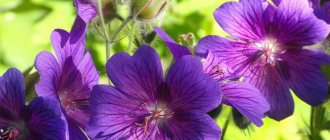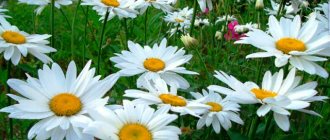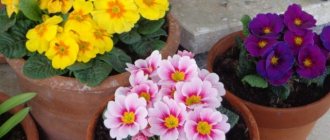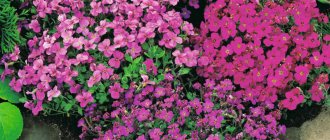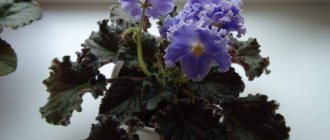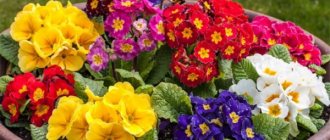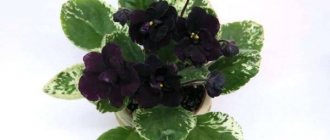Time for planting in pots
Geranium grows very beautifully on balconies, in large pots in the garden; gardeners often use decorative pots with pelargonium for a variety of design solutions. Often several bushes with different colors are planted.
- There are no problems when planting geraniums in decorative pots. In spring, the plant can be planted at a time that is convenient. But provided that the pots can be removed from the street or covered in case of zero temperature. Overgrown pelargonium tolerates cold well, but does not tolerate frost.
- Another important condition for a successful transplant is the absence of flowers on the bushes. Flowering plants take root very poorly, so replanting during this period is best avoided.
- At first, planted and established plants should be taken out into the garden only during the day, and when the danger of freezing passes, you can leave them overnight.
Features of caring for plants in winter
In winter, pelargonium is at rest; in order for it to delight you with beautiful blooms next year, you need to help it rest well. In order to grow beautiful geraniums, the following conditions must be met:
- It is necessary to water rarely when the top layer of soil dries out.
- You need to keep the plant in a cooler place; a window sill is good here.
- It is necessary to protect the plant both from drafts and from hot dry air near the radiator.
- In winter, geranium does not need additional nutrition; feeding should begin only at the end of February.
- Excessive lighting in winter is also not required, therefore, if possible, it is better to avoid placing the flower on a southern windowsill.
How to plant geraniums correctly
Perennial garden geranium quickly develops long roots. Allow the young shoots to take root well and grow undisturbed for the first time: dig a deep hole so that about 20 cm of loose soil remains under the longest root. There should be at least 30 cm between the holes. Before planting, treat the rhizomes with a disinfectant solution and the lower sections of the cuttings with growth stimulants.
Planting is carried out in early spring or autumn. Place a mound of fertile soil at the bottom, install the rhizome and distribute the underground shoots evenly over the soil elevation. Cover with soil and water to compact the soil. The first year there will not be very many leaves; they will not protect the flower garden from weeds. To avoid weeding, mulch the soil. Pelargonium, asters or other annuals can fill the voids.
Bury the cut cuttings into the soil by about 5 cm. Until the shoots take root, they require care. Protect the sprouts from frost with film or non-woven material. Make sure the soil is moist, but the water does not stagnate. In hot weather, all plantings in the first days should be shaded from the scorching rays of the sun.
Breeding outdoors
Geranium propagation is possible:
- seeds;
- seedlings;
- dividing the rhizome;
- cuttings;
- self-seeding.
Self-sowing is when ripe geranium fruits spontaneously open and the seeds scatter around the surrounding area. In spring, seedlings can be found far from the main plantings of the plant.
Thus, self-seeding allows you to update the appearance of the garden plot, but on the other hand, the gardener does not get the garden design he expected. That is why, in order to prevent self-seeding, unripe fruits must be removed.
Attention! If you want to propagate geranium plantings, you can easily get new plants by dividing an adult bush in early autumn. To propagate any part of the plant, it is enough to plant it in the ground, water it and cover it with film.
Both annual pelargonium and perennial garden geranium are a colorful, bright decoration of the garden throughout the summer. Moreover, all representatives of the geranium family are not only decorative, but also unpretentious, not requiring complex care.
Planting and care
Geranium feels great in open ground, but its beauty will be fully revealed if you provide the necessary care. First of all, decide on the landing site:
- The plant requires a lot of light, but does not tolerate hot, scorching sun rays, so a bright place, slightly shaded during the midday hours, is best suited.
- The flower easily adapts to light partial shade, almost without losing its flowering splendor. A flowerbed near the house, illuminated only half of the day, or the trunks of an apple tree are also perfect.
- Find out exactly the type and variety of the plant. Modern selection offers both dwarf bushes for borders and quite powerful, up to 70 cm, mid- and long-range plants.
As with many garden plants, you should prepare the soil in advance: remove weeds, dig it up, apply humus or complex fertilizer (it is better to do this at least a month before planting). Geranium does not tolerate stagnant water, so on heavy soils, be sure to place a drainage layer in the planting hole. You will have to dig a big hole: the flower is famous for its powerful, long roots.
Garden geranium is unpretentious
Adding soil, watering and mandatory mulching - numerous leaves actively evaporate moisture. For the same reason, it is worth closely monitoring the flower during the summer: in hot, dry weather, small but regular watering is needed. The plant itself will signal this - the usually straightened and elastic leaves will droop slightly. Geranium will be grateful if you feed it with nitrogen fertilizer in the spring, and potassium-phosphorus supplements will prolong flowering. But even without this, it will delight you with lush greenery and bright flowers. For most varieties, shelter for the winter is not required.
When choosing neighbors to plant together, pay attention to the combination of colors and the architecture of the plants. Geranium is good on its own, but it also harmonizes perfectly with plants with large flowers (roses, peonies, datura), creating an excellent background with abundant carved foliage and small flowers.
Next to decorative deciduous species (hosta, periwinkle, clasp), the flowering bush itself will sparkle with new colors, and proximity to cereals, thyme or catnip will give the flowerbed the appearance of a natural lawn or forest edge.
Features of growth on the street
Outdoors you can grow both annual geranium, which is more correctly called pelargonium, and perennial geranium, which is the most popular among gardeners.
It loves warmth, so it is usually planted outside only for the summer months, and then brought into the warmth. In the garden, sunny areas are more suitable for it, but partial shade will not prevent it from blooming all summer. Some varieties for the garden plot:
- hanging (for flowerpots) Ville de Paris and Lachskonigin with pink-salmon flowers;
- Holstein with pink inflorescences;
- Carnaval with double scarlet flowers with white splashes;
- Le Pirat with dark cherry double flowers;
- Sybil Holmes with large double flowers, pink on the outside and almost white on the inside;
- zonal (Zonal pelargoniums) - planted in the garden for the summer using container planting;
- thyroid or ivy-leaved (Pelargonium peltatum) with creeping shoots;
- Enzett Richards Schrader – double flowers have a salmon-pink color;
- Suprema - purple flowers in the form of small roses;
- Shimmer - large flowers of a coral shade.
Important! Perennial garden geranium, unlike pelargonium, is frost-resistant and is outdoors all year round.
A big plus of garden plantings of geranium is that due to the essential oils released, weeds do not grow well near it.
Planting geraniums in the garden and caring for the crop
The ornamental varieties of garden geranium that exist today are owed to the interest of breeders from Holland and Great Britain in this plant. Despite the fact that these cultivated species have become brighter, their flowering is more abundant and longer, geraniums in the garden require the selection of conditions close to those in which their wild ancestors grew.
When geraniums are planted in open ground in the spring, the planting site is chosen depending on the variety and type:
- Meadow, Himalayan or magnificent outdoor geraniums will actively grow and bloom if the plants are in the sun and given plenty of water.
- In dry corners of the garden, where there is a lot of sun, the large-flowered and red-brown variety is irreplaceable.
- Georgian geranium looks good on an alpine hill.
- If there is a damp corner in the shade of trees at your summer cottage, marsh geranium will grow beautifully here.
- Balkan geranium, when planted and cared for at the dacha, easily tolerates drought and shading.
All geraniums have branched long roots that tolerate transplantation extremely poorly. To reduce the stress of this procedure and simplify subsequent care, a fairly deep planting hole is made for planting geraniums in the garden. Its depth should be several centimeters greater than the length of the roots spread over the nutrient soil at the bottom of the hole. After careful backfilling, the planting site is watered and the soil on top is mulched.
Since most species grow significantly in a couple of years, there should be at least 20–30 cm between individual geraniums in the garden. And yet, even such an unpretentious plant that can stand up for itself needs support. Caring for geraniums in the garden after planting consists of:
- in regular watering that meets the needs of a particular plant type;
- in fertilizing, the first of which, using an infusion of compost and peat, is carried out immediately after transplantation;
- in the autumn pruning of withered foliage and the summer removal of faded inflorescences.
Spring for geraniums should begin with fertilizing with nitrogen fertilizer. It will push the plant to form lush foliage, and after a month a complex product is applied to the plants, which contains nitrogen, phosphorus, potassium and microelements. Species accustomed to living in mountains or arid areas require less fertilizer than lowland varieties.
Perennial garden geranium is an unusual, undemanding and very attractive green decoration for any site. The plant is universal and can be successfully used in single and group plantings without requiring special care.
Types and varieties
Currently, breeders have bred about 70 species of ivy-leaved pelargoniums. Ampelous geranium has undergone a long selection, thanks to which varieties with varied petal colors have appeared - plain and with edging (or strokes). The varieties also differ in the structure of the flower - they can be simple and symmetrical, or double and rosebud. Some varieties of ivy geranium have decorative foliage with yellow or pinkish edges, similar to ivy leaves, but stiffer.
Summer rain
Pelargonium ampelous Summer rain
Pelargonium ampelous Summer rain reaches 80-100 centimeters in length. The leaves are green and smooth and can grow up to 8 centimeters. There are 5-8 simple flowers in the umbrella. Flowering begins in May and continues until mid-autumn.
The plant is unpretentious, suitable for both indoor growing and outdoor cultivation in the summer.
Loves bright sun and moderate watering. Excessive watering and spraying will cause the plant to rot.
The soil for sowing seeds should consist of peat and sand, and for an adult plant, heavy soil with the addition of clay is suitable, since the plant’s homeland is mountainous. In winter, the temperature in the room should not fall below 10 degrees and should not exceed 15 degrees.
Can be used as a ground cover plant in summer under large trees or for flowerpots and balcony boxes.
Crystal Queen
Pelargonium Crystal Queen
Pelargonium Crystal Queen branches strongly, forming a powerful, spreading bush. Only two plants are enough for one pot. Very strong stems are resistant to winds and stretch up to 30 centimeters, forming a lush green cap, covered with white flowers during flowering. Flowering begins in May and ends in September.
For long-lasting abundant flowering, it is necessary to constantly remove faded flowers. Prefers southern and western windows when grown at home. There are pink and red hybrid varieties.
Tuscany
Geranium ampelous (ivy-leaved) Tuscany
This type of pelargonium has several varietal forms, distinguished by a variety of colors. The plant can grow up to 50 centimeters and bloom from May until the onset of frost. The flowers are semi-double, the petals are round, of different colors, the inflorescence is large, and when blooming, they form a spherical shape. The plant is cold-resistant - able to survive at temperatures around 0 degrees. During winter maintenance, it is necessary to reduce watering and lower the temperature to 10 degrees.
Tuscany Eva
This variety of flower is most loved by gardeners because of its short growth and beautiful snow-white flowers. The height of the bush reaches half a meter. It begins to bloom in May and pleases its owner with flowering until the frost.
Toscana Josina
Characteristic features of the variety: double flowers with a rich lilac hue and an abundance of small two-color leaves.
Toscana Okka
The plants will delight their owner with bright orange flowers collected in inflorescences. On the petals of Toscana Okka flowers. as if painted, white stripes.
Toscana Malaika
This is an early blooming pelargonium variety with purple-pink inflorescences. The Toscana Malaika bush blooms profusely. No less popular for breeding and growing are the varieties “Amethyst” or “Rhapsody”.
Toscana Pia
Angel
This plant is not too tall. It can grow up to 30 centimeters in height. Outwardly, it looks like a pansy. Flower growers often grow it at home. This variety is quite hardy compared to others. and it is not difficult to care for. To make the composition look more decorative, you can plant several flowers at once in one container. So, the bushes look more lush.
Tornado
This variety is the result of the work of Dutch breeders. Bushes of the "Tornado" variety are low, about 30 centimeters. Bright red buds bloom on it. In gardens and apartments it can be seen growing in flowerpots and hanging baskets.
Amethyst
An excellent hanging variety that is used for interior decoration. Looks impressive and chic in beautiful hanging baskets. Richly colored greenery with a waxy coating is a beautiful frame for amethyst-purple double flowers. The variety grows surprisingly quickly.
Bernardo
Compact pelargonium with scarlet showy rose-like flowers. Curly petals look unusual against the background of light green foliage.
Crock-o-Day
The variety is simply amazing, variegated. The plant is decorated with large semi-double flowers of a soft lilac color with a pink tint. Light whitish stains on the petals and burgundy thin lines in the middle of the inflorescence give the flowers a velvety effect.
Crocodile
A beautiful variegated variety. The foliage looks as if a skilled artist painted the emerald leaves with a thin brush, dusting them with gold. The neat bush is decorated with coral semi-double inflorescences. It won't go unnoticed.
Deep Red
Delightful lilac double flowers, framed at the ends with light tints. On the reverse side, the petals are snow-white. It seems that the flowers have a white lining. The rays of overripe cherry color extending from the center add spectacularity. And all this splendor is collected in huge inflorescences.
Decora Pink
An amazing plant with curly light green leaves with dark green edges. Even if she didn’t throw away the flowers, she would already look impressive. And the flowers are simply marvelous: bright pink-neon colored original inflorescences blooming wildly. This variety is great in hanging baskets.
Drezden Apricot
Delightful, chic ampel. The bush grows and develops well. The greenery grows quickly. Flowering earlier, lush. The flowers are unusually beautiful: large, semi-double, soft apricot color with a dusty rose tint. The upper petals seem to be outlined with burgundy-colored tongues.
How does garden geranium propagate?
Geraniums are propagated by cuttings, seeds and by dividing the bush.
Germination of seeds
The seed method is used quite rarely, since it is very labor-intensive and does not always give a positive result:
- Collected or purchased seeds are laid out on nutritious soil, lightly pressed with a finger, and not deepened too much.
- The soil is moistened with a spray bottle, the container with planting material is covered with film or glass. You need to place the container in a warm place.
- The film must be opened daily to ventilate the ground. Watering is carried out as needed, when the top layer of soil dries out.
When several full leaves appear on the seedlings, they can be planted in the garden. To get abundant flowering by summer, seedlings must be prepared in February. When to plant geraniums in open ground in the spring depends on weather conditions - there should be no night frosts.
Attention! In order not to miss the moment of ripening of the box, you can put a paper bag on it, since the seeds scatter very easily with the wind
Geranium seeds
Rooting cuttings
Geraniums can be propagated in open ground by cuttings for the summer. This is the easy way:
- Several shoots are cut from an adult plant.
- The cuttings are placed in a container of water, which is placed in a warm room.
The roots will begin to form in about 2-3 weeks. Another way is to treat the cut with a biogrowth stimulator, and then deepen it into a moistened soil mixture. Planting geranium seedlings outside and caring for them does not cause any special trouble for the gardener. The main condition is the absence of frost, stable, warm weather.
Dividing the bush
The advantage of this method of propagating geraniums is that it is very easy and contributes to the rejuvenation of the mother bush. Time: March-April or end of August:
- The plant is dug up and damaged parts of the root system are removed.
- The rhizome is divided into parts, each must have at least 1 bud.
- Divided rhizomes must be planted in nutritious soil and watered.
Transplanting geraniums
Time: spring or autumn. Planting in a new place is carried out using the transshipment method: on the dug up bush, it is necessary to preserve a lump of old earth around the roots. You need to add fertilizer to the new hole.
It is highly not recommended to replant geraniums; this can destroy the adult plant.
What to do if something goes wrong?
If, after planting, the plant begins to weaken and spots begin to appear on the leaves, the plant may have been infected by parasitic insects. In this case, it is necessary to treat the plant with insecticides.
There are times when, after transplanting geraniums under normal weather conditions, frost occurs. It is not advisable to replant geraniums in pots - unnecessary stress for the plant can lead to illness and a long recovery. You just need to insulate the plant. Cover the soil around the bush with mulch, and the bush itself with covering material.
It is worth noting that the correct and step-by-step actions recommended by experienced gardeners regarding preparing the plant for replanting and subsequent care after it will not cause any problems. It is worth understanding that during the first 2 weeks the flower is especially vulnerable to pests, temperature changes and soil conditions; you need to take good care of it.
Geranium is a universal plant that feels great both in a flowerpot and in open ground in the summer. Geranium has been used in landscape design for a long time and this flower has proven itself well as an ornamental plant, undemanding in care.
Diseases and pests
If geraniums are not properly cared for, a number of problems can arise.
- If your pelargonium grows in a dark container, it is exposed to drafts, or it is waterlogged in winter, then its leaves begin to turn yellow. Yellowing can also be caused by lack of drainage, dryness and excess nitrogen in the soil.
- If the plant does not bloom, the reason for this may be that the pot is too large, which is why the flower will devote all its energy to growing roots.
- Also, delays in flowering occur due to pinching. Royal geraniums need to be pinched less often than others, as they may not bloom at all.
- Warm wintering and excess nitrogen fertilizers also cause this effect.
- If geranium leaves turn yellow and dry out, the culprit is a spider mite, which can be recognized by the thin webs on the foliage.
- White coating on the leaves indicates powdery mildew.
- Geranium foliage curls when there is a lack of nitrogen, light, or moisture. Spider mites or viral diseases may also be to blame. The latter, in addition to leaf curling, appear in crooked colors.
- If your geranium is not growing, it may be that it is not getting enough light or the room is too hot and dry. Another reason is poor soil or its depletion.
- Small leaves appear without pruning. They may also indicate the aging of the plant.
- Limp stems and leaves indicate excess moisture, resulting in rotting of the roots, which often leads to the death of the flower; or about its lack.
- When there is little light, geranium leaves begin to fall.
- Blackening of stems and leaves occurs due to various rots or “black leg”.
How to form plants correctly
In order for the bushes to be lush and voluminous, it is necessary to pinch the shoots. This procedure begins in February and continues throughout March. Thus, the plant:
- The crown is formed;
- The growth of fresh shoots is stimulated;
- The bush is rejuvenated;
- The foundations for flower inflorescences are laid.
The end of winter is an excellent time for the best results; the plant does not suffer much and tolerates pruning painlessly. When pinching, two or three lower buds are left, the remaining shoots are removed, the upper shoots are also pinched, but the axillary shoots located on top should also be removed. Pruning should be done gradually; the plant should not immediately lose half of its green mass and shoots, otherwise it will not have the strength to flower after a long period of restoration of health.
Diseases and pests
Geranium has a wonderful property - it repels insects that can harm it. But sometimes this green “fighter” is still exposed to diseases and pests.
- Gray rot. The entire plant is covered with bluish-gray spots and bloom. Occurs due to high humidity, lack of lighting and lack of heating. For treatment you need to use fungicides.
- Powdery mildew. Characterized by a white coating. It is necessary to remove the affected areas and treat with a fungicide (Bordeaux mixture).
- Rust. Brown-rusty spots appear on the leaves. Subsequently, the leaves dry out. Fungicides will help get rid of rust.
- Alternaria blight. Brown spots appear on geranium leaves with a light center and a velvety coating. You can get rid of it by treating the plant with fungicides.
- Ring spot. Light spots shaped like a ring form on the plant. The leaves then curl up and hang like umbrellas.
- Verticillium wilt. The leaves begin to turn yellow below, then completely turn yellow and wilt. Stems and inflorescences can also be affected. The disease appears if the soil is too dry.
- Root and stem late blight. Because of this disease, the plant withers and rots. It is necessary to reduce the amount of watering and treat the flower with special products.
- Edema. Characterized by the appearance of bubbles on the leaves. It is necessary to remove the diseased plants immediately so that the disease does not spread to the entire plant. To avoid the occurrence of such a disease, the flower is planted in warm, well-drained soil. Moisture-loving neighbors are not suitable for geraniums.
The main flower pests are:
- aphids (ash infusion - 1 spoon of wood ash per 1 liter of water - used to combat it);
- whitefly;
- thrips;
- caterpillars (they are collected by hand);
- spider mite (it appears if geranium grows in a dry and hot climate; to get rid of spider mites, the plant is treated with a soap solution).
Geranium can get sick due to improper care:
- the leaves have turned yellow and become withered - this is facilitated by a violation of the watering regime;
- the stems become bare - the plant does not have enough light;
- spots appear and the flower begins to rot - due to a fungal infection.
Is there a need to dig up flowers for the winter?
Not only outdoor, but also various indoor varieties of geranium are able to withstand winter frosts well without leaving the open soil. Closer to the onset of winter, the leaves must be cut off and the soil and bases of the stems covered with mulch. The coating can only be removed in the spring, when the last cold weather has gone. Then the plant will be able to produce new shoots.
If, nevertheless, it was decided to transplant the plant back into the pot for the winter season, it is necessary to dig it up even before the temperature outside goes below zero. A drainage layer must be placed at the bottom of the selected pot. The dimensions of the pot or container should be such that the main root of the bush can easily fit into it without deformation.
How to care for a flower growing in open ground?
- Temperature, humidity, lighting. Garden geranium will grow and develop normally at an air temperature of 12 degrees Celsius.
She is very demanding about lighting, since without it her growth and flowering will stop. With a lack of light, the leaves will also begin to fade. But direct sunlight is also unacceptable for it, otherwise a burn will form on the leaf plate. Garden geranium tolerates dry and humid air well, but does not like spraying. - Watering: It is necessary to moisten the flower regularly, but watering should be moderate. Over-watering should not be allowed, as this can lead to the development of root rot. But drought is also disastrous for geranium, because because of this it will stop blooming and its leaves will wither. It is better to moisten the soil after its top layer has dried. Use settled warm water for this.
- Feeding: Geranium does not need abundant nutrition.
Most often, compost and peat, which were added to the hole before planting, are enough for her. Excess nutrients added to the soil will have a bad effect on flowering. Before the buds bloom, it is necessary to use a fertilizer containing phosphorus. The use of potassium compounds (once every 2 weeks) during the formation of inflorescences and during active flowering will allow you to obtain large and lush inflorescences. - Pruning. Geraniums must be pruned to obtain a dense bush, which gives it a compact and decorative appearance. In addition, pruning also has a preventive purpose, as it helps protect young shoots and leaves from diseases. To do this, it is necessary to remove all dried flowers and leaves, which are so attractive to gray rot.
Taking proper care of the flower
The key to successful cultivation of ampelous geraniums is proper watering. The plant loves moisture, but you should not be too zealous with moisture, as this can lead to rotting of the root system. Water the flower only after the top layer of soil has completely dried. Excess water that comes out into the pan must be drained. In the summer, the plant is watered frequently; with the onset of cold weather, the amount of moisture is reduced to a minimum.
It is also impossible to allow the entire earthen clod to dry out completely, otherwise it will negatively affect flowering. It is not worth spraying ampelous geraniums to increase the humidity level, because moisture on the leaves can lead to rotting. For healthy development, the plant requires an influx of fresh air, so it is necessary to frequently ventilate the room, but avoid drafts directed at the geranium.
During the growing season, ampelous geranium is periodically fed, observing a time period of two weeks. At the beginning of spring, when the plant begins to actively grow, fertilizers containing nitrogen are needed, which stimulates the development of green mass. As soon as buds appear on geraniums, they resort to fertilizing rich in phosphorus and potassium, which directly affects the quality of flowering.
Special fertilizers can be purchased at the store or made yourself using diluted milk or onion peels. With the onset of autumn, they stop feeding the plant.
In the fall, a rejuvenating pruning procedure is carried out, shortening all elongated and bare shoots. In the spring, you can repeat the procedure if the geranium has grown greatly over the winter. Proper pruning helps to form a compact but lush bush. Ampelous geraniums are replanted if the root system has grown greatly and began to emerge through the drainage holes. Usually the procedure is carried out once every two years, selecting a pot two centimeters larger in diameter.
Planting by seeds
Garden geranium propagates not only by rhizomes, but also by seeds. Planting seeds takes a little longer. It is characteristic that with such propagation the varietal qualities disappear, and a completely different variety of this type of garden crop is obtained.
It is better to take fresh seeds for sowing. But collecting them is not easy. You need to be patient. The seeds are in boxes, the flaps of which burst when ripe, and the seeds scatter in all directions. The pod with immature seeds is green. And when they are ripe, it turns brown.
But the shades of seed color are different and depend on the variety. You can put a paper bag on the pod, which will serve as a guarantee that the seeds will not scatter when fully ripe, and you will collect them. Of course, there is a lot of hassle, but it’s worth it, because next year the seedlings will bloom.
It happens that garden geranium produces abundant self-sowing. Planting and care require additional effort if you do not want the plant to multiply uncontrollably. To do this, you need to trim off immature seed pods and all faded flowers.
Quite unpretentious and unusually beautiful ampelous pelargonium
The attention of any resident of the metropolis is attracted by the bright and lush flowers that decorate buildings and flower beds and create a festive mood. But not everyone knows what kind of plant this is and where it comes from.
And those who decide to purchase this flower for themselves have no idea how reproduction and cultivation occurs, as well as what kind of care it needs. This article will help you understand all these issues.
But not everyone knows what kind of plant this is and where it comes from. And those who decide to purchase this flower for themselves have no idea how reproduction and cultivation occurs, as well as what kind of care it needs. This article will help you understand all these issues.
Main diseases, pests and their control
If mistakes are made during planting or care, the plant may become sick or be affected by pests.
Most often, infections occur with the following diseases:
- Leaf spotting. Signs: brown, brown, light green spots on the foliage. Diseased organs must be destroyed by burning. If the disease is at an initial stage, then treatment with biofungicides - Fitosporin-M, Gaupsin - will help. In case of severe infection, stronger drugs will be required.
- Powdery mildew. Symptoms are a white powdery coating on the leaves. Fungicides and colloidal sulfur are used for treatment.
- Gray rot. Appears as gray spots on the leaves. It is treated with “Fundazol”, “Vitarol”, “Rovral”.
Did you know? All organs of geranium have medicinal properties. They are used to prepare remedies for various diseases in official medicine and folk healing.
The most common pests that can attack geraniums are:
- Ticks. Small yellow dots on the foliage will tell you that they have started on a flower. These parasites like to actively reproduce during hot and dry periods. The fight against them consists of wiping with a soapy solution, treating with insecticides “Fitoverm”, “Bi-58”, Karate”, “Iskra-M”, “Aktellik”.
- Aphid. This dangerous harmful insect, when colonized en masse on a plant, can literally drink all the juices from it and lead to death. Signs of infection are yellowing and curling leaves, lethargy, leaf fall. The methods of dealing with aphids are the same as with mites.
- Whitefly. It is easy to notice the presence of this pest - white butterflies fly over the flowers. However, it is not the moths that pose the danger, but their larvae that feed on the leaves. You can fight whiteflies with herbal decoctions and infusions, tobacco infusion. In case of severe infection, spraying with chemicals will be required - “Aktellik”, “Fitoverm”, “Aktara”, “Fufanon”.
In addition to diseases and pests, the plant may suffer from other problems, which will be indicated by changes in appearance:
- The leaves turn yellow and the ends dry out. One possible reason is lack of moisture. Lost leaves need to be removed and watering gradually increased.
- No flowering. There are several reasons: lack of light, cold temperatures, lack of mineral elements, prolonged lack of pruning.
- Formation of brown growths on the underside of the leaf. The reason is strong root moisture and high humidity. There is an urgent need to reduce watering and adjust its regime.
Important! Yellowing of geranium foliage some time after planting is normal. Yellow leaves need to be removed and quality plant care provided.
After some time, the flower adapts.
What problems might arise?
Sometimes even the most undemanding plant has troubles. Let's look at the most common problems with geraniums:
- The leaves look like a rag, hang, and fall off when touched. These are the consequences of excess moisture. If you have had a rainy summer, thinning your plants can help. Otherwise, you may lose all landings.
- The leaves are drying. Not enough water. Perhaps you only water the top layer and the lower roots do not receive a drop of moisture. Mulching will help. The water will not roll off and evaporate.
- If gray mold appears on the leaves, you should stop watering completely.
- Whiteflies or aphids can settle on geraniums. These pests can be destroyed manually or treated with insecticides, otherwise they will suck all the juices out of the plant.
- If pelargonium does not bloom, and this often happens with the most beautiful varieties, if all conditions are not provided. See if the flower has enough light? Have you fed the plant?
Types of planting material
You can plant a bush from an indoor pot directly into a flower bed, but there are a number of other ways to plant this plant. Overgrown bushes will significantly increase the area of the plant, which will make the flower garden even more attractive. Geranium is a houseplant, but it has adapted well to life and can reproduce in several ways:
- Seeds that are difficult to obtain. Another problem with seed pelargonium is the difficulty of growing plants. Small seedlings are very whimsical and quickly die from heat or too much watering. In addition, after planting the seeds, the bush will bloom only next spring. The plant is biennial.
- By cuttings. They are cut from an adult flowering bush. This rooted and established plant will bloom in the year of planting, but closer to autumn, the bush blooms well then in the winter months on the window. Cut a cutting from an adult bush, take its upper part, about 10-15 cm in length, with one or two leaves.
- In divisions. This method allows you to get beautiful flowering geranium bushes within 2-3 weeks after planting. To propagate by divisions, a bush from a pot is simply divided into several, so that each separated part (division) has a stem. The planting method allows you to obtain the most viable planting material.
Description of ampelous geranium
Pelargonium is a genus of plants that includes more than 200 species of shrub and herbaceous plants belonging to the geranium family. There is also a separate genus of shrub - Geranium, but plants of the genus Pelargonium are common among gardeners. By its nature, Pelargonium grows on dry lands or on mountain slopes. Its unpretentiousness to water and beauty delight gardeners, because not every plant can be so beautiful and, at the same time, not need careful care. Most flowers literally dry out if they lack any moisture. But Ampelous geranium is not a weak plant. Another feature of this species is its ease of reproduction and long flowering period. In early spring, flowers begin to bloom and decorate your garden plot or balcony, and end their colorful posing only in late autumn, when almost all plants lose their beauty and leaves fall on the trees. The point is not that geranium is able to bloom for so long, but that this feature is combined with voluminous lush flowers of a complex and curved structure
You want to admire such flowers for a long time, and since geranium is a shrub, you can use it to divert attention from problem areas in your garden or dacha. This species is so hardy that you can’t even believe it, because beautiful flowers are always lethargic, weak and you constantly need to monitor them so that all your care is not in vain
But this species doesn’t mind the heat, the rain, or the draft. In general, geraniums are divided into two groups: shrubs and hanging ones. And the shrubs, in turn, are flowering and fragrant. Ampelous geranium is a plant that can be classified as a hanging garden. Because of this, it is often used when planning decor at dachas.
Pelargonium flattened is one of the ampelous types of geraniums. Its shoots are about 90 cm in length. In addition, pelargonium not only does not need to spray the leaves, but can also die from it. After all, then rot will start in the leaves and destroy the light-loving plant.
Planting perennial garden geranium in open ground
It is recommended to plant geraniums in open ground in early spring or autumn. To do this, you should prepare the place and soil in advance.
Selecting a location
To grow geraniums outdoors, you need to select a place in advance. You should first familiarize yourself with the requirements of the flower depending on the variety. Some types of this flower need to be planted in well-lit places, while others, on the contrary, are more comfortable in shaded areas.
Note! It is not recommended to choose places where groundwater comes close to growing geraniums. Varieties that are distinguished by tall shoots are best planted in the middle or background of the flower bed.
Low-growing flowers are perfect for garden paths and borders. Varieties that are distinguished by tall shoots are best planted in the middle or background of the flower bed. Low-growing flowers are perfect for garden paths and borders.
How to prepare the soil and flower for planting
The intensity of growth and abundance of flowering directly depends on how competently and correctly the geranium is planted in open ground. For planting, it is best to select light, loose soil. It must first be dug to the depth of a shovel, humus or special soil mixtures must be added.
Important! Garden pelargonium and geranium can be planted only after cold weather, when the soil has completely warmed up. Basically, planting a flower in open ground is done by cutting from an adult bush.
Before this, the seedlings need to be properly prepared. Before planting, the cutting must be kept in a stimulating solution and also treated with activated carbon. After all the measures taken, the seedling can be transferred to the soil only after 2-3 weeks
Basically, planting a flower in open ground is done by cutting from an adult bush. Before this, the seedlings need to be properly prepared. Before planting, the cutting must be kept in a stimulating solution and also treated with activated carbon. After all the measures taken, the seedling can be transferred to the soil only after 2-3 weeks. If you plan to grow geranium with a formed root system, then you can plant it immediately after processing.
Transplantation and soil
Transplantation is always stressful for geraniums. It is needed only in case of root growth or if you urgently need to save the plant from overwatering. After purchase, replanting pelargonium is especially risky, since it needs at least a month to adapt.
In any case, geraniums can only be replanted in spring and summer. In winter, the transplanted plant may not take root in the new soil.
How to replant geraniums?
First, make sure that its flower stalks have not begun to bloom, otherwise you just need to break them off or postpone replanting until after flowering. Next, follow these step-by-step instructions:
- Choose a new pot slightly larger in size than the previous one;
- Prepare the soil for replanting geraniums. It should be loose, well-drained, neutral acidity. A universal substrate for flowering indoor plants is suitable;
- Place a layer of drainage 1.5-2 cm thick at the bottom of the pot.
Place the geranium in a new pot together with the old earthen ball (or without it, if the plant is flooded) to such a depth that the trunk is hidden in the soil, and only the center of the bush remains visible on the surface. Holding the plant suspended, begin pouring soil into the pot. After the first two handfuls of soil, you can add a slow-release universal fertilizer, such as Osmocote or DuraTec, at a rate of 3 g per 1-liter pot.
Planting and care
Garden geranium takes root very quickly. The hole for the plant must be made in such a way that about twenty centimeters of loose soil remain under the longest of the roots. There should be a distance of at least thirty centimeters between the holes. Before planting, the plants must be disinfected and the cuttings treated with root.
The first year after planting there will be few leaves, so it is better to mulch the ground around the bushes to protect the flowerbed from weeds.
Perennial geranium is a non-capricious plant that has retained the ability to withstand adverse conditions, diseases and pests. Therefore, you only need to maintain its growing conditions in a well-groomed condition.
The plant tolerates drought, but if you want to observe its lush growth and abundant flowering, then water it as the soil dries out.
It is not necessary to prune geraniums after flowering. Already yellowed inflorescences fall under the foliage without spoiling the appearance of the flower garden. But, if you want to prolong flowering and make it abundant, then periodically it is worth cutting off wilted buds to allow new ones to appear.
Later, from the bursting fruits, seeds will fall to the ground, which will sprout next year. If you don’t want to deal with thinning the bushes, you can immediately remove the seed pods.
Geranium leaves contain a large amount of essential oils with phytoncides, the aroma of which pests cannot tolerate. This is an excellent way to fight insects not only in the flower garden, but also in vegetable beds, where you can plant geranium bushes for this purpose.
Watering
Any variety of geranium loves regular, but very moderate watering. You need to water the plant especially carefully in the first months after planting. You need to slightly increase the amount of water during dry periods. You can determine the lack of moisture by the leaves of the plant, which begin to droop. There is no need to spray geraniums.
Fertilizer application
Fertilizing geraniums is carried out in the spring with nitrogen fertilizers. After 25-30 days, the bushes are fed again with complex fertilizers containing potassium and phosphorus. But there are varieties that do not need fertilizer in such quantities.
Geranium can grow in garden conditions for up to ten years. It is not demanding on the composition of the soil; it can grow in the sun and in the shade, depending on the variety. The plant does not require complex care or special attention; it overwinters quietly without special shelter.
Geranium is used not only in landscape design, medicine, but also in the manufacture of perfumes. And if you put geranium leaves in a jar of jam, it can last for a very long time. Therefore, don’t even think twice about it, plant geranium and enjoy its beauty!
Features of cultivation
Ampelous pelargonium will develop well in places where there is a lot of sunlight and no drafts. If you are going to keep the plant outdoors during the summer months, then do not forget to start the hardening procedure in the spring, periodically taking the pot with the climbing crop to the balcony. After this procedure, the plants will be able to tolerate noticeable drops in temperature, up to several degrees Celsius. Of course, when there is a threat of frost, it is better to put the flowers in a protected place.
Considering the fact that the ivy-shaped form of the plant in natural conditions is nothing more than a mountain crop, geranium at home cannot be called a plant that is demanding on the composition of the soil. But it will be better if you make sure there is enough drainage material at the bottom of the pot and prepare a soil mixture that includes a little clay.
Step-by-step instruction
Movement into soil by rhizome
It often happens that after the winter period, the stems of geraniums become very elongated - it loses its decorative appearance. There is a way out - transplant the plant into open ground, cutting off all the shoots, leaving 5-10 cm of stumps. You need to proceed as follows:
- Use a sterile instrument to trim the geranium.
- Treat the sections with an antiseptic.
- Moisten the soil in the flowerpot.
- Prepare the bed and dig holes corresponding to the size of the root system.
- Carefully remove the geranium along with the earthen lump.
- Place the roots in the hole and cover with soil, slightly compacting the soil around the bush.
- Pour over warm water.
Seedlings
Geranium seedlings are planted in open ground in mid-May, when the likelihood of morning frosts is minimal. Plants are planted in the prepared bed at a distance of 10-20 cm from each other and watered abundantly. For the first 2 weeks, the seedlings are shaded from direct sunlight, but care must be taken to ensure that the soil in the garden bed does not dry out.
Seeds
If you decide to grow geranium from seeds, then you should take care of this at the end of January, at the beginning of February, this is the only way you will get a flowering plant in the summer.
In order to sow seeds you need:
- Prepare a container for seedlings and appropriate soil - you can buy soil for seedlings at the store.
- Place good drainage on the bottom of the box, then a layer of soil.
- The seeds are distributed over the surface at a distance of 5 cm from each other and sprinkled with a small layer of soil.
- Moisten the soil by spraying and set up a small wig, covering the box with plastic wrap.
- After 2 weeks, the first shoots will appear, at this time the film should be removed and the container with seedlings should be placed in a warm, bright place, but without direct sunlight.
As soon as the time for planting in open ground approaches, the seedlings are planted as described earlier.
How to transfer from a pot to the street?
Let's look at how to plant a plant from a pot into the ground. Once all the preparatory work has been completed, you can begin planting geraniums in open ground. When transplanting an adult flower, the rhizome is first treated with a stimulating substance. You can buy it at a flower shop, but you must use it strictly according to the instructions. The algorithm for planting geraniums in open ground is as follows:
The soil needs to be dug up to a depth of 35 cm. Distribute compost over the entire surface of the dug bed in a layer of 10 cm, and mix it well with the top layer of soil. The pit must be of a certain depth - at least 25 cm
In this case, you need to pay attention to the roots of the plant. Place a mixture of peat, garden soil and sand at the bottom of the hole - you can buy it ready-made in the store. Carefully remove the plant from the pot, being careful not to damage the root system. Place the geranium roots in the prepared hole and cover with soil, slightly compacting the soil around the bush. Water moderately with warm water. When planting a number of plants, it is worth maintaining the distance between the bushes - optimally from 45 to 60 cm, depending on the type of geranium.
When planting a number of plants, it is worth maintaining the distance between the bushes - optimally from 45 to 60 cm, depending on the type of geranium.
